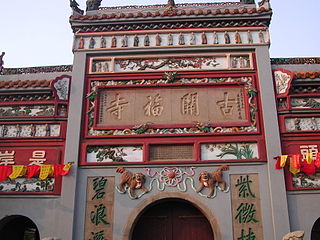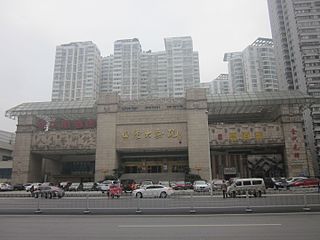
Wangcheng District is one of six urban districts of Changsha, the capital of Hunan province, China. the district is bordered to the north by Miluo City and Xiangyin County of Yueyang, to the west by Heshan District of Yiyang and Ningxiang County, to the south by Yuelu and Kaifu Districts, to the east by Changsha County. Located in the northsouth of the City proper in Changsha, Wangcheng covers 951.06 km2 (367.21 sq mi) with registered population of 560,567 and resident population of 562,100. The district has 10 subdistricts and 5 towns under its jurisdiction, the government seat is at Gaotangling Subdistrict.

The Roman Catholic Diocese of Jiangmen/Kongmoon is a diocese located in the city of Jiangmen in the Ecclesiastical province of Guangzhou in China.

Tianxin District is one of six urban districts of Changsha, the capital of Hunan province, China. the district is bordered by Yuetang District of Xiangtan to the south, Yuhua District to the east, Furong and Kaifu districts to the north, Yuelu District across the Xiang river to the west. Located in the southern central Changsha, Tianxin covers 141.05 km2 (54.46 sq mi) with population of 604,600. The district has 14 subdistricts under its jurisdiction, the government seat is at Qingyuan Subdistrict.

Yuhua District is one of six urban districts of Changsha, Hunan province, China. the district is bordered by Yuetang District of Xiangtan to the south, Changsha County to the east, Furong District to the north, Tianxin District to the west. Located in the southern central Changsha, Yuhua covers 304.9 km2 (117.7 sq mi) with population of 764,700. The district has 12 subdistricts and 1 town under its jurisdiction, the government seat is at Guitang subdistrict.

Kaifu Temple is a Buddhist temple located in Kaifu District of Changsha City, Hunan province in the People's Republic of China. It includes Entrance, Hall of the Great Heroes, Assisted dnyana, Dining Room, etc. Kaifu Temple belongs to the Yangqi sect and Linji school of Buddhism. The temple is built within a 16,000 square metres (170,000 sq ft) area of land. For the reason that it was first built earlier than Changsha city, so there is a saying that "there comes first the Kaifu Temple, then the Changsha city".
Xijiang Township(simplified Chinese: 溪江乡; traditional Chinese: 溪江鄉; pinyin: Xijiang Xiang), is an rural township in Liuyang City, Changsha City, Hunan Province, People's Republic of China. As of the 2000 census it had a population of 19,952 and an area of 90.6 square kilometers. Xijiang township merged to Guankou subdistrict on November 18, 2015.
The Hunan College of Finance and Economics is a university located in Yuelu District, Changsha, Hunan, China.
Changsha Normal University is a university located in Changsha, Hunan, China.

The Tian Han Grand Theatre is a theatre on West Laodong Road in Tianxin District of Changsha, Hunan, China. The theater, named after the pioneering Chinese playwright Tian Han, comprises the Great Theater, Concert Hall, Tian Han Memorial Hall, Art Gallery and the Masses Culture Plaza.
The 27th Golden Eagle Awards took place in Changsha, Hunan, China, on October 12, 2014.

Juzizhou Subdistrict is a subdistrict of Yuelu District in Changsha, Hunan, China. It is historically the Shuiluzhou Subdistrict formed in 1950s. The subdistrict has an area of 16.02 square kilometres (6.19 sq mi) with a permanent resident population of about 168,000. The subdistrict has 2 villages and 8 communities under its jurisdiction.
Joseph Huang Bingzhang is a Chinese Roman Catholic Bishop of Shantou, Guangdong. He is now the vice-president of Chinese Patriotic Catholic Association. He was a deputy to the 11th and 13th National People's Congress.
Peter Fang Jianping is a Chinese Roman Catholic Bishop of Roman Catholic Diocese of Hebei, China. He is also vice-president of the Bishops Conference of the Catholic Church in China (BCCCC).

Methodius Qu Ailin is a Chinese Roman Catholic Bishop of Roman Catholic Diocese of Hunan, China.

Joseph Zhang Yinlin was a Chinese Catholic priest and the current bishop of Weihui.
Paul Francis Zhang Mingqian was a Chinese Catholic priest, Franciscan, doctor, prisoner for faith. He was recognized as a legal bishop by both the Holy See and the Chinese government.

Joseph Tang Yuange is a Chinese Catholic priest and Bishop of the Roman Catholic Diocese of Chengdu since 2016.
Paul Meng Zhuyou is a Chinese Catholic clergyman and Metropolitan Archbishop of the Roman Catholic Archdiocese of Taiyuan from 2013.
Peter Luo Xuegang is a Chinese Catholic priest and Bishop of the Roman Catholic Diocese of Suifu since 2012. He is a member of the Chinese Patriotic Catholic Association.













